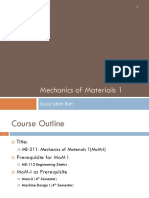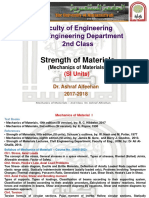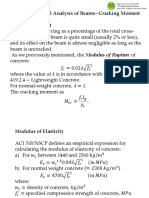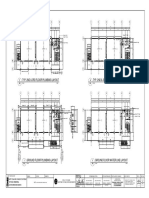Chapter 1 - Stress and Strain
Chapter 1 - Stress and Strain
Uploaded by
Luke Nate SarmientoCopyright:
Available Formats
Chapter 1 - Stress and Strain
Chapter 1 - Stress and Strain
Uploaded by
Luke Nate SarmientoOriginal Description:
Copyright
Available Formats
Share this document
Did you find this document useful?
Is this content inappropriate?
Copyright:
Available Formats
Chapter 1 - Stress and Strain
Chapter 1 - Stress and Strain
Uploaded by
Luke Nate SarmientoCopyright:
Available Formats
7/9/2016
Chapter 1: Stress and Strain
7/9/2016
1.
EQUILIBRIUM OF
DEFORMABLE BODIES
7/9/2016
Introduction
Mechanics of Materials/Strength of Materials
- a branch of mechanics that studies the internal effects of
stress and strain in a solid body that is subjected to an external
loading.
Stress is associated with the strength of the material from
which the body is made, while strain is a measure of the
deformation of the body.
In addition to this, mechanics of materials includes the study
of the bodys stability when a body such as a column is
subjected to compressive loading.
7/9/2016
Lets review!
ARES 1 Engineering Mechanics
7/9/2016
Equilibrium of Deformable Body
- Surface Forces are caused by the direct
contact of one body with the surface of
another. In all cases these forces are
distributed over the area of contact
between the bodies.
External Loads
If this area is small in comparison with
the total surface area of the body, then the
surface force can be idealized as a single
concentrated force, which is applied to a
point on the body.
7/9/2016
Equilibrium of Deformable Body
If the surface loading is applied along a
narrow strip of area, the loading can be
idealized as a linear distributed load,
w(s).
The resultant force of w(s) is equivalent
to the area under the distributed
loading curve, and this resultant acts
through the centroid C or geometric
center of this area.
External Loads
7/9/2016
Equilibrium of Deformable Body
A body force is developed when one body
exerts a force on another body without
direct physical contact between the
bodies.
Examples include the effects caused by
the
earths
gravitation
or
its
electromagnetic field.
External Loads
7/9/2016
Equilibrium of Deformable Body
Support Reactions
The surface forces that develop at the supports or points of
contact between bodies are called reactions.
As a general rule, if the support prevents translation in a given
direction, then a force must be developed on the member in that
direction. Likewise, if rotation is prevented, a couple moment must
be exerted on the member.
7/9/2016
Equilibrium of Deformable Body
Support Reactions
7/9/2016
Introduction
Equations of Equilibrium
Equilibrium of a body requires both a balance of forces, to prevent the
body from translating or having accelerated motion along a straight
or curved path, and a balance of moments, to prevent the body from
rotating.
3-Dimension
Coplanar/
2-Dimension
10
7/9/2016
Equilibrium of Deformable Body
Normal force, N
This force acts perpendicular to the area.
It is developed whenever the external
loads tend to push or pull on the two
segments of the body.
Internal Loads
Shear force, V
The shear force lies in the plane of the
area and it is developed when the external
loads tend to cause the two segments of
the body to slide over one another.
11
7/9/2016
Equilibrium of Deformable Body
Torsional moment or torque, T
This effect is developed when the external
loads tend to twist one segment of the
body with respect to the other about an
axis perpendicular to the area.
Internal Loads
Bending moment, M
The bending moment is caused by the
external loads that tend to bend the body
about an axis lying within the plane of the
area.
12
7/9/2016
Equilibrium of Deformable Body
Coplanar Internal Loads
13
7/9/2016
Examples
(Equilibrium of Deformable Bodies)
14
7/9/2016
Example: Equilibrium of Deformable Bodies
1. Determine the resultant internal loadings acting on the cross
section at C of the cantilevered beam.
15
7/9/2016
Example: Equilibrium of Deformable Bodies
2.
Determine
the
resultant
internal
loadings acting on the
cross section at C of the
machine shaft shown on
the figure below. The
shaft is supported by
journal bearings at A and
B, which only exert
vertical forces on the
shaft.
16
7/9/2016
Example: Equilibrium of Deformable Bodies
3. Determine the resultant
internal loadings acting on
the cross section at G of
the beam shown below.
Each
joint
is
pin
connected.
17
7/9/2016
2.
STRESS
18
7/9/2016
Introduction to Stress
Assumptions:
1. The material is continuous/
continuum;
2. The material must be cohesive.
19
7/9/2016
Introduction to Stress
Stress
It is the quotient of the force and area which
describes the intensity of the internal force
acting on a specific plane (area) passing
through a point.
20
7/9/2016
Introduction to Stress
Normal Stress (sx, sy, and sz)
- it is the intensity of the force (F)
acting normal to a certain area (A). If
the normal force or stress pulls on
A, it is referred to as tensile stress,
whereas if it pushes on it is called
compressive stress.
State of Stress
21
7/9/2016
Introduction to Stress
Shear Stress (txz, txy, tzx, tzy, tyx, tyz)
- it is the intensity of the force (F) acting
tangent to a certain area (A).
State of Stress
Units
SI: Pascal, Pa (1 Pa = 1 N/m2), kPa, Mpa
English: psi (pound per square inch)
or kpi (kilopound per square inch)
22
7/9/2016
Average Normal Stress in an Axially Loaded Bars
This bar is
Prismatic.
It is also
Isotropic.
It is
Homogeneous.
Result:
Uniform Deformation!!!
23
7/9/2016
Average Normal Stress in an Axially Loaded Bars
Due to the uniform
deformation of the
material,
it
is
necessary that the
cross section be
subjected
to
a
constant
normal
stress distribution.
24
7/9/2016
Average Normal Stress in an Axially Loaded Bars
Where:
s = average normal stress at
any point on the cross-sectional
area;
P = internal resultant normal
force, which acts through the
centroid of the cross-sectional
area;
A = cross-sectional area of the
bar where s is determined.
25
7/9/2016
Examples
(Average Normal Stress in an Axially
Loaded Bars)
26
7/9/2016
Example: Average Normal Stress in an
Axially Loaded Bars
1. The bar in the figure below has a constant width of 35mm and
a thickness of 10mm. Determine the maximum average normal
stress in the bar subjected to the loading as shown.
27
7/9/2016
Example: Average Normal Stress in an
Axially Loaded Bars
2. The 80-kg lamp is supported by
two rods AB and BC as shown in the
figure. If AB has a diameter of 10
mm and BC has a diameter of 8
mm, determine the average normal
stress in each rod.
28
7/9/2016
Example: Average Normal Stress in an
Axially Loaded Bars
3. The casting shown in the figure
is made of steel having a specific
weight of gst=490 lb/ft3. Determine
the average compressive stress
acting at points A and B.
29
7/9/2016
Example: Average Normal Stress in an
Axially Loaded Bars
4. Member AC as shown is
subjected to a vertical force of 3 kN.
Determine the position x of this
force so that the
average
compressive stress at the smooth
support C is equal to the average
tensile stress in the tie rod AB. The
rod has a cross-sectional area of
400 mm2 and the contact area at C
is 650 mm2.
30
7/9/2016
Average Shear Stress
31
7/9/2016
Average Shear Stress
Shear Stress is defined as
the stress component that
acts in the plane of the
sectioned area. As shown on
the figure, if the supports are
considered rigid, and F is
large enough, it will cause the
material of the bar to deform
and fail along the planes
identified by AB and CD.
32
7/9/2016
Average Shear Stress
Where:
=
V = F/2
tavg = average shear stress at
the section, which is assumed to
be the same at each point
located on the section;
V = internal resultant shear
force on the section determined
from
the
equations
of
equilibrium;
A = area at the section
33
7/9/2016
Examples
(Average Shear Stress)
34
7/9/2016
Example: Average Shear Stress
1. Determine the average shear stress in the 20-mm-diameter
pin at A and the 30-mm-diameter pin at B that support the
beam.
35
7/9/2016
Example: Average Shear Stress
2. If the wood joint in the
figure has a width of 150 mm,
determine the average shear
stress developed along shear
planes aa and bb. For each
plane, represent the state of
stress on an element of the
material.
36
7/9/2016
Example: Average Shear Stress
3. The inclined member in the
figure is subjected to a
compressive force of 600 lb.
Determine
the
average
compressive stress along the
smooth areas of contact
defined by AB and BC, and the
average shear stress along the
horizontal plane defined by
DB.
37
7/9/2016
Allowable Stress
One method of specifying the allowable load for a
member is to use a number called the factor of
safety. The factor of safety (F.S.) is a ratio of the
failure load, Ffail to the allowable load Fallow.
38
7/9/2016
3.
STRAIN
39
7/9/2016
Deformation
Whenever a force is applied to a
body, it will tend to change the
bodys shape and size. These
changes are referred to as
deformation, and they may be
either
highly
visible
or
practically unnoticeable.
40
7/9/2016
Normal Strain
Normal strain is defined as the change
in length of a line per unit length.
Where:
eavg (epsilon) = average normal strain;
Ds = new length;
Ds = original length.
41
7/9/2016
Normal Strain
When e (or eavg) is positive the initial
line will elongate, whereas if e is
negative the line contracts.
42
7/9/2016
Shear Strain
Shear strain
It is a deformation that causes not only
line segments to elongate or contract,
but they also cause them to change
direction. If we select two line segments
that are originally perpendicular to one
another, then the change in angle that
occurs between these two line
segments is referred to as shear strain.
43
7/9/2016
Shear Strain
gnt = is the shear strain measured
in radians (rad.)
Where:
44
7/9/2016
Examples
(Normal and Shear Strain)
45
7/9/2016
Example: Normal and Shear Strain
1. The slender rod shown in the figure is
subjected to an increase of temperature
along its axis, which creates a normal strain
in the rod of ez=40x10-3z1/2, where z is
measured in meters. Determine the following:
(a) The displacement of the end B of the rod
due to the temperature increase; and
(b) The average normal strain in the rod.
46
7/9/2016
Example: Normal and Shear Strain
2. When force P is applied to the rigid
lever arm ABC in the figure, the arm
rotates counterclockwise about pin A
through an angle of 0.05. Determine
the normal strain developed in wire
BD.
47
7/9/2016
Example: Normal and Shear Strain
3. Due to a loading, the plate is
deformed into the dashed shape
shown the figure. Determine (a)
the average normal strain along
the side AB, and (b) the average
shear strain in the plate at A
relative to the x and y axes.
48
7/9/2016
Any questions?
49
You might also like
- BS 2782-3-Methods 320A To 320F-1976 - (2021-04-12 - 10-00-25 AM)Document18 pagesBS 2782-3-Methods 320A To 320F-1976 - (2021-04-12 - 10-00-25 AM)Mahendra Singh Budhathoki100% (1)
- 2 4 4 Engineering Lettering GuidelinesDocument2 pages2 4 4 Engineering Lettering GuidelinesLuke Nate SarmientoNo ratings yet
- 1 Normal StressDocument40 pages1 Normal StressTerise SangalangNo ratings yet
- CEMDEF40 Module 2 - Simple StressesDocument27 pagesCEMDEF40 Module 2 - Simple StressesengrrrrNo ratings yet
- Module 1 Fundamentals of Deformable Bodies StressDocument16 pagesModule 1 Fundamentals of Deformable Bodies StressJune del MundoNo ratings yet
- CEMDEF40 Module 6 - Statically Indeterminate Members and Thermal StressDocument13 pagesCEMDEF40 Module 6 - Statically Indeterminate Members and Thermal StressengrrrrNo ratings yet
- Shear and Moment Diagram - Wikipedia, The Free EncyclopediaDocument10 pagesShear and Moment Diagram - Wikipedia, The Free EncyclopediaPrabhat MishraNo ratings yet
- INTRODUCTION (Cont..) : TIN 205-TIN31 Engineering MechanicsDocument47 pagesINTRODUCTION (Cont..) : TIN 205-TIN31 Engineering Mechanicsgundul paculNo ratings yet
- Tension and Compression 2023 - 1Document25 pagesTension and Compression 2023 - 1Enoch Afful100% (1)
- Module 1.0-SIMPLE STRESS - Axial-NormalDocument20 pagesModule 1.0-SIMPLE STRESS - Axial-NormalJoseph Berlin JuanzonNo ratings yet
- Module 3 STRUCTURAL THEORY MidtermDocument15 pagesModule 3 STRUCTURAL THEORY MidtermMatet MaglipacNo ratings yet
- Analysis of Joints and ConnectionsDocument14 pagesAnalysis of Joints and ConnectionsDave Harrison FloresNo ratings yet
- Assignments On Prestressed ConcreteDocument1 pageAssignments On Prestressed Concreteourebooks100% (1)
- Strength of MaterialsDocument17 pagesStrength of MaterialskalpanaNo ratings yet
- Module 1 Series 1 Aug 16 2021Document20 pagesModule 1 Series 1 Aug 16 2021pamelaNo ratings yet
- Civil Engineer INGDocument26 pagesCivil Engineer INGDavidAdedokunNo ratings yet
- Macaulay's MethodDocument20 pagesMacaulay's MethodMalingha SamuelNo ratings yet
- Structural Theory 1 (Part 3)Document14 pagesStructural Theory 1 (Part 3)GinoOcampo100% (1)
- Chapter 01 - StressDocument68 pagesChapter 01 - StressMuhammad HasnainNo ratings yet
- Chapter 1 Simple StressesDocument27 pagesChapter 1 Simple StressesLalaine RamosNo ratings yet
- Chapter 4 Equilibrium PF Rigid Body & ForceDocument61 pagesChapter 4 Equilibrium PF Rigid Body & ForceIsabelNo ratings yet
- Module 1 Mechanics of Deformable BodiesDocument3 pagesModule 1 Mechanics of Deformable BodiesWency LagumbayNo ratings yet
- Mechanics of Rigid BodiesDocument15 pagesMechanics of Rigid BodiessoulcivicNo ratings yet
- Simple Stress StrainDocument141 pagesSimple Stress StrainvelavansuNo ratings yet
- Module #1 - Simple Stress: Engr. Lito I. MauroDocument38 pagesModule #1 - Simple Stress: Engr. Lito I. MauroJeffrey ManansalaNo ratings yet
- Statics of Rigid Bodies 1Document3 pagesStatics of Rigid Bodies 1Rosette de AsisNo ratings yet
- Statics 101Document4 pagesStatics 101Justine Ejay MoscosaNo ratings yet
- 2 - Simple Stresses (Shearing)Document16 pages2 - Simple Stresses (Shearing)Lorene Ropeta.No ratings yet
- ES11 LE2 SamplexDocument3 pagesES11 LE2 SamplexAnna Louise WyNo ratings yet
- Strength of Materials: (SI Units)Document11 pagesStrength of Materials: (SI Units)Fitra VertikalNo ratings yet
- I.Condition For The Equilibrium of A Particle: Stiffness KDocument5 pagesI.Condition For The Equilibrium of A Particle: Stiffness KJirah LacbayNo ratings yet
- Indetermine StructureDocument8 pagesIndetermine Structuremaloy100% (1)
- Lecture 1 - Stress-Strain RelationshipDocument26 pagesLecture 1 - Stress-Strain RelationshipSri Jaiandran100% (1)
- Tutorial 3Document2 pagesTutorial 3piyush kumarNo ratings yet
- Shear and Moment in BeamsDocument1 pageShear and Moment in BeamsMariz Ellaine BaltazarNo ratings yet
- Final Quiz - Mechanics of Deformable BodiesDocument1 pageFinal Quiz - Mechanics of Deformable BodieschbarcenalNo ratings yet
- Problem Set 1 CE Part 2Document3 pagesProblem Set 1 CE Part 2Deus PhilipNo ratings yet
- LR4.1 Equilibrium of Rigid Bodies MMI MEC101Document22 pagesLR4.1 Equilibrium of Rigid Bodies MMI MEC101HannahSamonteNo ratings yet
- Types of Structures and Loads: June 2011Document18 pagesTypes of Structures and Loads: June 2011Weilong LokNo ratings yet
- Engg Mech and Strength of MaterialsDocument73 pagesEngg Mech and Strength of MaterialsClaire Necesito100% (1)
- Engineering Mechanics Lecture 1Document15 pagesEngineering Mechanics Lecture 1Khalid YousafNo ratings yet
- Tension Compression and ShearDocument27 pagesTension Compression and ShearRizal Muhammad FaradayNo ratings yet
- Measurement of Directions and AnglesDocument45 pagesMeasurement of Directions and AnglesXielleNo ratings yet
- Strength of Materials Objective QuestionDocument64 pagesStrength of Materials Objective QuestionMuhammad AhmadNo ratings yet
- Simple Stress PDFDocument18 pagesSimple Stress PDFJohn Philip NadalNo ratings yet
- Mechanics of Deformable BodiesDocument2 pagesMechanics of Deformable BodiesJeff LaycoNo ratings yet
- CE224 MDB - Module 1: StressDocument8 pagesCE224 MDB - Module 1: Stressaileen eustaquioNo ratings yet
- Fundermental Surveying - Theory and Practice PDFDocument28 pagesFundermental Surveying - Theory and Practice PDFSupriya Roy100% (1)
- Area Moment MethodDocument49 pagesArea Moment MethodJÜnn BatacNo ratings yet
- RCD Lesson 1b Flexural Analysis of Beams (Cracking Moment)Document14 pagesRCD Lesson 1b Flexural Analysis of Beams (Cracking Moment)EJ Dela CruzNo ratings yet
- Masonry WorksDocument17 pagesMasonry WorksAudrina Seige Ainsley ImperialNo ratings yet
- Mechanics of Deformable Bodies Quiz 2Document4 pagesMechanics of Deformable Bodies Quiz 2FerrolinoLouieNo ratings yet
- Torsion Mod1Document49 pagesTorsion Mod1Beveh G SupSupNo ratings yet
- Chapter 9 - Centroid and CGDocument24 pagesChapter 9 - Centroid and CGnishant361No ratings yet
- 3-Dimensional Drawings, or Photographic or Pictorial Drawings. Isometric DrawingDocument12 pages3-Dimensional Drawings, or Photographic or Pictorial Drawings. Isometric DrawingHarshit SolankiNo ratings yet
- Chapter 2 Part 2 - Deflection Unit Load Method 2017Document53 pagesChapter 2 Part 2 - Deflection Unit Load Method 2017kennypennyNo ratings yet
- Solved Problems Normal StressDocument3 pagesSolved Problems Normal StressA'TINSB19No ratings yet
- LESSON-1Document45 pagesLESSON-1ricationgco73No ratings yet
- Strength of Materials Chapter OneDocument16 pagesStrength of Materials Chapter Oneif0121No ratings yet
- Reza Isp AbstractDocument1 pageReza Isp AbstractLuke Nate SarmientoNo ratings yet
- Reza Isp AbstractDocument1 pageReza Isp AbstractLuke Nate SarmientoNo ratings yet
- Typ. 2Nd & 3Rd Floor Plumbing Layout Typ. 2Nd & 3Rd Floor Water Line LayoutDocument4 pagesTyp. 2Nd & 3Rd Floor Plumbing Layout Typ. 2Nd & 3Rd Floor Water Line LayoutLuke Nate SarmientoNo ratings yet
- Determining Leach Field Sizes 1Document5 pagesDetermining Leach Field Sizes 1Luke Nate SarmientoNo ratings yet
- Chapter 1 Ecw422 MoocDocument32 pagesChapter 1 Ecw422 MoocNur FatehaNo ratings yet
- Standard Test Method For Vickers Hardness of Metallic MaterialsDocument10 pagesStandard Test Method For Vickers Hardness of Metallic MaterialsSanjay RamasamyNo ratings yet
- Design of Flexible Bush Pin Coupling For Asamnew PRORESSDocument13 pagesDesign of Flexible Bush Pin Coupling For Asamnew PRORESSLewi100% (1)
- Wettability Study of Lead Free Solder Paste and It PDFDocument5 pagesWettability Study of Lead Free Solder Paste and It PDFShahvez ShahvezNo ratings yet
- The Failure of Composite Materials Under High-Velocity Liquid ImpactDocument20 pagesThe Failure of Composite Materials Under High-Velocity Liquid ImpactlufabaoNo ratings yet
- Software Verification: AISC-360-10 Example 002Document9 pagesSoftware Verification: AISC-360-10 Example 002Mohamed Abo-ZaidNo ratings yet
- CTT Elastomeric BearingsDocument20 pagesCTT Elastomeric Bearingsjajaytt100% (1)
- What Is The Difference Between Soil Yielding and Shear Failure of Soil - QuoraDocument2 pagesWhat Is The Difference Between Soil Yielding and Shear Failure of Soil - QuoraVinithaNo ratings yet
- Acoustic Properties of Sound Absorbing, Poly-Mer-Modified Porous Cement MortarsDocument12 pagesAcoustic Properties of Sound Absorbing, Poly-Mer-Modified Porous Cement MortarsDomenico VizzariNo ratings yet
- S Sutradhar Publication Feb 2021Document10 pagesS Sutradhar Publication Feb 2021Subham AdhikariNo ratings yet
- Effect of Solution Annealing Heat Treatm PDFDocument3 pagesEffect of Solution Annealing Heat Treatm PDFaltieri1No ratings yet
- Effect of Shear Connectors On Local Buckling and Composite Action in Steel Concrete Composite Walls (Zhang Et Al, 2014)Document9 pagesEffect of Shear Connectors On Local Buckling and Composite Action in Steel Concrete Composite Walls (Zhang Et Al, 2014)Hamid GoodarziNo ratings yet
- Polymer Melt Flow Analysis: Appendix BDocument4 pagesPolymer Melt Flow Analysis: Appendix Bنرگس باویNo ratings yet
- PPDocument12 pagesPPsanto_r05No ratings yet
- TaskDocument2 pagesTaskMahmoud Abdel-SalamNo ratings yet
- School of Physics and Astronomy Junior Honours Thermodynamics GJA 2013-2014Document4 pagesSchool of Physics and Astronomy Junior Honours Thermodynamics GJA 2013-2014Francisco De León-Sotelo EstebanNo ratings yet
- ME 80: Mechanics of Materials, Winter 2014Document4 pagesME 80: Mechanics of Materials, Winter 2014GIMMEMYBURRITONo ratings yet
- Finite Element Simulation Analysis of Double Nosing Process in The Assembly of Spherical Plain BearingsDocument7 pagesFinite Element Simulation Analysis of Double Nosing Process in The Assembly of Spherical Plain BearingsInternational Journal of Research in Engineering and ScienceNo ratings yet
- Objective Questions in Engineering MechanicsDocument6 pagesObjective Questions in Engineering MechanicsrajkumardotcomNo ratings yet
- Pin Connected Tension MemberDocument2 pagesPin Connected Tension MemberAUNGPSNo ratings yet
- Chapter 3: Fundamentals of CrystallographyDocument51 pagesChapter 3: Fundamentals of CrystallographyAli ZbayelNo ratings yet
- Calculation Report For PHC Pile: I. Input Data For Pile's Material I.1. Effective Presstress: ValueDocument3 pagesCalculation Report For PHC Pile: I. Input Data For Pile's Material I.1. Effective Presstress: ValuehuhumaluNo ratings yet
- Van Der Waals Mixing RulesDocument11 pagesVan Der Waals Mixing RulesDiego1980bNo ratings yet
- TOR Steel and TMT BarsDocument1 pageTOR Steel and TMT Barsramyap959862100% (1)
- Breaking Point: Testing Tensile Strength: DemonstrationDocument10 pagesBreaking Point: Testing Tensile Strength: Demonstrationabdul_imran_17No ratings yet
- RCDocument31 pagesRCShita AlemieNo ratings yet
- Safe Load Carrying CapacityDocument2 pagesSafe Load Carrying CapacityKulal SwapnilNo ratings yet
- Strength Design Methods For Glass StructuresDocument147 pagesStrength Design Methods For Glass Structuresامين الزريقيNo ratings yet





























































































